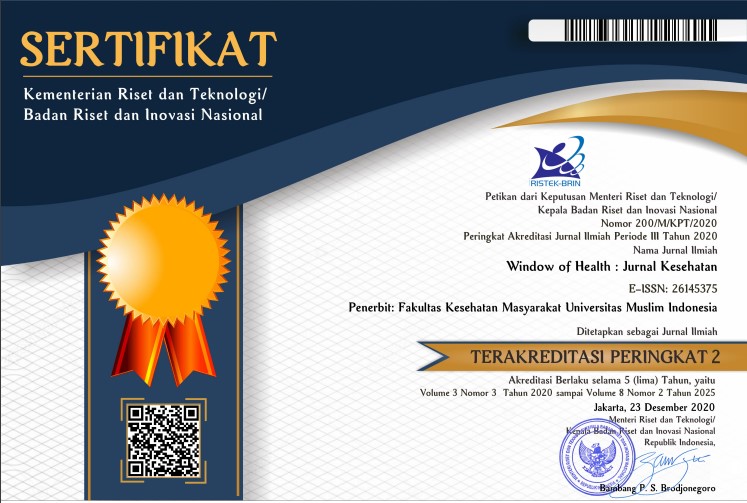Airborne Benzene Concentrations Increase Trans, Trans-Muconic Acid (tt-MA) Levels and Liver Function in Workers in The Manufacturing Industry
Abstract
The use of benzene as a solvent in the manufacturing industry can be dangerous because it is volatile, toxic, and carcinogenic. Exposure to benzene occurs through inhalation of the chemical in the air, which can enter the human body through the respiratory system. The levels of trans, trans-Muconic Acid (tt-MA), which is used to metabolize benzene, can be affected by the amount of exposure to the chemical. This study aims to determine the differences in exposure to benzene in the air by measuring the tt-MA indicators and liver function of workers in the manufacturing industry. This research uses an observational and cross-sectional approach, with a population of 158 employees from both administration and production units. The sample size for the study is 16 respondents, selected using the consecutive sampling technique. The research instrument uses a questionnaire and examines urine samples using the in-house method. Blood samples are examined using IFCC 37 C. The data is processed using the independent-sample t-test and Pearson correlation. The results show that the level of benzene in the air is below the threshold of 0.5 ppm. However, there is a significant difference in the results of tt-MA and SGOT (p less than 0.05), while the levels of SGPT (p greater than 0.05) show no significant differences. In conclusion, there are differences in the tt-MA and SGOT exposure levels between workers in the production and toxicity units, while SGPT does not show significant differences. It is recommended that the industry maximizes the use of local exhaust ventilation and prohibits smoking.
References
Karmini M, Kamaludin A, Kesehatan Lingkungan M, Universitas Airlangga F, Kesehatan Lingkungan Poltekkes Kemenkes Bandung Jln Pajajaran No J, Bandung K. Extract of Snake Plant (Sansevieria sp.) As a Reducer of Indoor Air Pollution, Volatile Organic Compounds (VOC) Benzene. JURNAL KESEHATAN LINGKUNGAN: Jurnal dan Aplikasi Teknik Kesehatan Lingkungan. 2022;19(1):1-6. doi:10.31964/JKL.V19I1.342
Vinceti M, Rothman KJ, Crespi CM, et al. Leukemia risk in children exposed to benzene and PM10 from vehicular traffic: a case–control study in an Italian population. Eur J Epidemiol. 2012;27(10):781. doi:10.1007/S10654-012-9727-1
Biological monitoring of chemical exposure in the workplace : guidelines. Accessed November 13, 2022. https://apps.who.int/iris/handle/10665/41856
Benzene | NIOSH | CDC. Accessed November 13, 2022. https://www.cdc.gov/niosh/topics/benzene/
PERATURAN MENTERI TENAGA KERJA DAN TRANSMIGRASI. Accessed November 13, 2022. www.hukumonline.com
Kirkeleit J. Benzene exposure and hematological effects among offshore workers exposed to crude oil. Published online 2007.
Martínez-Velázquez M, Maldonado V, Ortega A, Meléndez-Zajgla J, Albores A. Benzene metabolites induce apoptosis in lymphocytes. Exp Toxicol Pathol. 2006;58(1):65-70. doi:10.1016/J.ETP.2006.03.010
Yatulaini F, Tualeka AR, Jalaludin J, Russeng SS. The Relationship between Duration of Benzene Exposure with Liver Enzymes in Car Painting Workshop Workers. The Indonesian Journal of Occupational Safety and Health. 2021;10(3):361-370. doi:10.20473/IJOSH.V10I3.2021.361-370
Taheri E, Yousefinejad S, Dehghani F. Investigation of some effective factors on urinary metabolites in biological monitoring of benzene, toluene, and xylene compounds. https://doi.org/101080/0306731920222097871. Published online 2022:1-16. doi:10.1080/03067319.2022.2097871
FakhriNur. Hubungan Kadar Trans, Trans-Muconic Acid (Tt-Ma) Dalam Urin Dengan Profil Hematologis Pada Pekerja Spbu Coco Pertamina Mor V. Thesis. Universitas Airlangga; 2016.
Loomis D, Guyton KZ, Grosse Y, et al. Carcinogenicity of benzene. Lancet Oncol. 2017;18(12):1574-1575. doi:10.1016/S1470-2045(17)30832-X
Zhang LX, Zhu Y, Bie LJ, Attaqwa Y, Mahachandra M, Prastawa H. Analysis of benzene exposure considering workers characteristic in the oil and gas industry Ultra-Sensitive Benzene Detection and Gas Sensing Mechanism of (C 4 H 9 NH 3 ) 2 PbI 2 Br 2 Organic-Inorganic Perovskite Analysis of benzene exposure considering workers characteristic in the oil and gas industry. doi:10.1088/1757-899X/909/1/012059
Carletti R, Romano D. Assessing health risk from benzene pollution in an urban area. Environ Monit Assess. 2002;80(2):135-148. doi:10.1023/A:1020691506835/METRICS
Agency for Toxic Substances and Disease Registry Division of Toxicology and Human Health Sciences. benzene_toxzine. Book. Published online 2007.
Dugheri S, Pizzella G, Mucci N, et al. Low-Dose Benzene Exposure Monitoring of Oil Refinery Workers: Inhalation and Biomarkers. Atmosphere 2022, Vol 13, Page 450. 2022;13(3):450. doi:10.3390/ATMOS13030450
Jalai A, Ramezani Z, Ebrahim K. Urinary Trans, Trans-Muconic Acid is Not a Reliable Biomarker for Low-level Environmental and Occupational Benzene Exposures. Saf Health Work. 2017;8(2):220-225. doi:10.1016/J.SHAW.2016.09.004
Wilbur SSKOF. TOXICOLOGICAL PROFILE FOR BENZENE. Published 2007. Accessed November 14, 2022. https://www.atsdr.cdc.gov/toxprofiles/tp3.pdf
Wang GT, Zhang MY, Chen X, et al. Highly selective and sensitive lanthanoid coordination polymer sensors for trans, trans-muconic acid, a biomarker of benzene. Polyhedron. 2020;189:114728. doi:10.1016/J.POLY.2020.114728
Chaiklieng S, Suggaravetsiri P, Kaminski N, Autrup H. Factors Affecting Urinary tt-Muconic Acid Detection among Benzene Exposed Workers at Gasoline Stations. International Journal of Environmental Research and Public Health 2019, Vol 16, Page 4209. 2019;16(21):4209. doi:10.3390/IJERPH16214209
Ahmed aa, alsalmi w, elhadi aa, almarabet mm. Adverse effects of benzene exposure on hematological and hepatic biochemical parameters of petrol filling workers in wadi al-hayah, libya article in european journal of pharmaceutical and medical research • december 2022 citations 0 reads 40 4 authors, including: adverse effects of benzene exposure on hematological and hepatic biochemical parameters of petrol filling workers in wadi al-hayah, libya. European Journal of Pharmaceutical and Medical Research. 2015;9001. Accessed March 26, 2023. https://www.researchgate.net/publication/365960277
Gupta N, Vyas S, Sankhla M, Punjabi P. Biochemical assessment of the hepatic functions of the petrol pump workers of Jaipur city Manisha Sankhla Biochemical assessment of the hepatic functions of the petrol pump workers of Jaipur city. Natl J Physiol Pharm Pharmacol. 2017;(10). doi:10.5455/njppp.2017.7.0516622052017
Verma Y, Rana SVS. Biological Monitoring of Exposure to Benzene in Petrol Pump Workers and Dry Cleaners. Ind Health. 2001;39:330-333.
Glass DC, Gray CN, Jolley DJ, et al. Leukemia risk associated with low-level benzene exposure. Epidemiology. 2003;14(5):569-577. doi:10.1097/01.EDE.0000082001.05563.E0
Goldman RAWMS. ATSDR Case Studies in Environmental Medicine Principles of Pediatric Environmental Health.; 2016. Accessed November 14, 2022. http://www.atsdr.cdc.gov/csem/csem.html.
Copyright (c) 2024 Kahar, Nia Yuniarti Hasan, Teguh Budi Prijanto, Ade Kamaludin

This work is licensed under a Creative Commons Attribution-NonCommercial-ShareAlike 4.0 International License.








